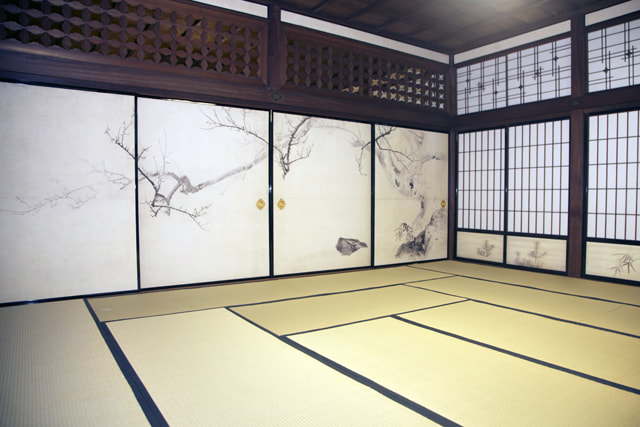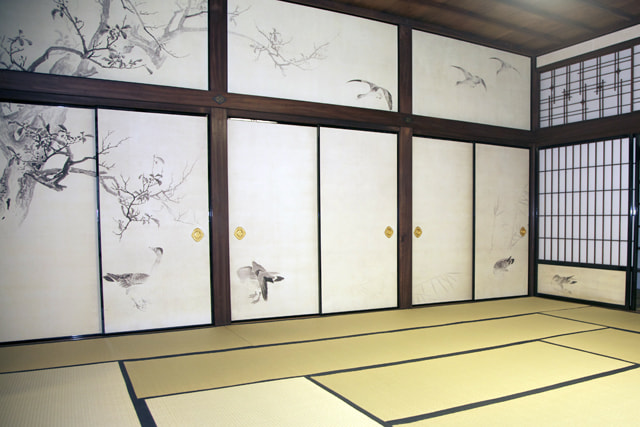
Maki Kobayashi, a public relations officer at the Tokyo National Museum guided us through the museum grounds.

Garden of the Tokyo National Museum
Seasonal flowers, such as cherry blossoms, add color to the garden of the Tokyo National Museum. The museum grounds were originally the precincts of Kan-eiji Temple, and the temple's living quarters was once built on the site where Honkan stands now. It seems that the garden was the temple's garden. It is said that, since the museum had a natural products division when it was established, a variety of flowers, trees and plants have been planted in the garden. Five teahouses called "Okyokan," "Kujokan," "Rokusoan," "Tengoan" and "Shunsoro" are built in the garden. There are also many historical monuments, including the stone monument of Hisanari Machida, the first director of the museum, five-storied pagoda, stone monument of the second Domestic Industrial Exposition and porcelain lantern.

In spring, a variety of cherry blossoms, including Edo-higan, Shofukuji, Mikado-yoshino and Kenrokuen-kiku cherries bloom, and the garden is crowded with cherry-blossom viewers.

Okyokan

Okyokan
This teahouse was built in 1742 as a drawing room of Myogen-in Temple in the suburbs of the present Nagoya City. Later, it was relocated to the premises of Takashi Masuda in Shinagawa, Tokyo, and then donated to the Tokyo National Museum in 1933. Since the teahouse has been known for the sliding-door paintings by Okyo Maruyama, it is called "Okyokan."
This teahouse was built in 1742 as a drawing room of Myogen-in Temple in the suburbs of the present Nagoya City. Later, it was relocated to the premises of Takashi Masuda in Shinagawa, Tokyo, and then donated to the Tokyo National Museum in 1933. Since the teahouse has been known for the sliding-door paintings by Okyo Maruyama, it is called "Okyokan."

Shunsoro
This teahouse was constructed as a rest house by Zuiken Kawamura during the Yodo River improvement work in the late 17th century (Jokyo and Genroku Periods). It was owned by Yasuzaemon Matsunaga (Jian) in 1936, and, in the following year, relocated to the grounds of Yanase Villa in Tokorozawa City, Saitama Prefecture. It was then donated to the Tokyo National Museum after the war, and finally moved to the garden in 1959.
This teahouse was constructed as a rest house by Zuiken Kawamura during the Yodo River improvement work in the late 17th century (Jokyo and Genroku Periods). It was owned by Yasuzaemon Matsunaga (Jian) in 1936, and, in the following year, relocated to the grounds of Yanase Villa in Tokorozawa City, Saitama Prefecture. It was then donated to the Tokyo National Museum after the war, and finally moved to the garden in 1959.

Kujokan
This teahouse was donated to the museum by Michihide Kujo. It was relocated from the premises of Marquis Kujo's residence in Akasaka, Tokyo. The colored landscape pictures by the Kano school adorn the paper pasted onto the interior walls, and the transom made of a single Chinese quince wood piece displays openwork of Japanese wisteria flower-shaped lozenges.
This teahouse was donated to the museum by Michihide Kujo. It was relocated from the premises of Marquis Kujo's residence in Akasaka, Tokyo. The colored landscape pictures by the Kano school adorn the paper pasted onto the interior walls, and the transom made of a single Chinese quince wood piece displays openwork of Japanese wisteria flower-shaped lozenges.

Tengoan
This teahouse was originally part of a tea-ceremony hut, which was built in Rokujizo in Fushimi, Kyoto, by Enshu Kobori in the early 17th century (Kanei Period). Later, it was relocated to the grounds of Jakkoin in Ohara, and then donated by Chiyo Shiobara to the museum in 1963.
This teahouse was originally part of a tea-ceremony hut, which was built in Rokujizo in Fushimi, Kyoto, by Enshu Kobori in the early 17th century (Kanei Period). Later, it was relocated to the grounds of Jakkoin in Ohara, and then donated by Chiyo Shiobara to the museum in 1963.

Rokusoan
This teahouse was built in the precincts of Jigen-in Temple in Nara by Sowa Kanamori during the period from 1648 to 1652 (Keian Period). It was relocated to the grounds of the museum in 1877.
This teahouse was built in the precincts of Jigen-in Temple in Nara by Sowa Kanamori during the period from 1648 to 1652 (Keian Period). It was relocated to the grounds of the museum in 1877.

Rokusoan's tea room

Okyokan / Drawing room 1
Pine trees are depicted on the walls of the tokonoma alcove, and plum trees are widely depicted on the sliding doors partitioning this room from the next room. Also, bamboos are depicted on the shoji screens with wooden panels in the lower part and on the walls of the staggered shelves, making a composition of so-called "Sho Chiku Bai," or a pine, a bamboo and a plum. These sliding-door pictures were stored in a storehouse in order to preserve the cultural properties, and visitors could not see the building's original state for a long time. Also, pictures on the paper pasted onto the walls had some preservation problems. Therefore, a research team, which would make reproductions of the pictures, was formed in 2005, and worked with Dai Nippon Printing Co., Ltd. to produce reproduction pictures by utilizing digital image processing technology. In 2007, 37 pictures by Okyo Maruyama and 4 pictures by Shurei Yamamoto were reproduced, and the pictorial space was restored to the original state.

A signature of Okyo is clearly reproduced on the digitally processed reproduction picture.

Room 1 / Pine tree on the walls of the tokonoma alcove


Okyokan / Drawing room 2 / Geese and Reeds (portion)
Geese swooping on a pond with reeds are carefully observed and depicted with perspective.

Maki Kobayashi, a public relations officer at the Tokyo National Museum guided us through the museum grounds.

In spring, a variety of cherry blossoms, including Edo-higan, Shofukuji, Mikado-yoshino and Kenrokuen-kiku cherries bloom, and the garden is crowded with cherry-blossom viewers.

Okyokan


Okyokan / Drawing room 2 / Geese and Reeds (portion)
Geese swooping on a pond with reeds are carefully observed and depicted with perspective.






















